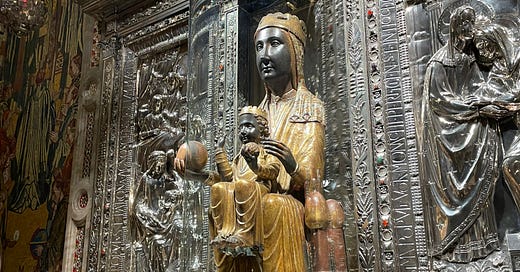The Goddess Without Reveals the Goddess Within
Chapter 9: The Ignatian Myth & Narrative Project
Our protagonist necessarily meets a goddess, or so Joseph Campbell tells us. The imagery is compelling, a cut scene taken right out of The Legend of Zelda. Link solves some puzzle and then—there she is! Squint your eyes just so, and even now you can almost see her materialize out of some mystical well, a hodgepodge of blinking lights and fairy magic.
For us in the Christian tradition—and Catholics in particular—we have an easy and obvious corollary over which Nintendo has no copyright claim: Mary, the Mother of God.
And yet, I’m hesitant. So much of Campbell’s writing in this particular area feels uncomfortably gendered: a woman in myth means this and a man in myth means that. I am no mythologist, no Campbellian scholar, and so in my very non-academic way, all I can say is this: I don’t care for it. This essentialism feels at best incomplete.
Still, as I reflected on this moment in our heroic journey, the Blessed Mother necessarily came to mind. For Ignatius of Loyola, Mary is foundational. And so, any pilgrimage through Ignatian spirituality is one taken in the company of Mary, the Mother of God.

“For she is the incarnation of the promise of perfection; the soul’s assurance that, at the conclusion of its exile in a world of organized inadequacies, the bliss that once was known will be known again,” Campbell writes of the so-called goddess and the role she can play in the sojourn of the hero (p 92).
I’m struck by this. We often look to Mary as someone who embodies perfection—that perfect “yes” to God, as it were. And yet, Mary is so much more than this, more, I think, than “perfection.” Mary, in the Christian understanding, was a human just like any of us with joys and challenges, sorrows and surprises.
Obsessing over her perfection can rob her of her humanness—and, I think, what she wishes to reveal to us: We, too, are human. We, too, are given opportunities to fully embody God, to welcome God’s Spirit into our very selves, to be Christ-bearers to the world. The “goddess” of our story desires to hold a mirror up so that we can see the same image of divinity sparkling in our very selves.
And that brings me to the next line from Campbell that I found helpful: “She can never be greater than [the hero], though she can always promise more than [the hero] is yet capable of comprehending.” (p 97)
Let’s discard any Campbellian impulse to limit or reduce women and instead let’s turn to Mary’s own words: “God has looked upon God’s handmaid’s lowliness; behold, from now on will all ages call me blessed.” (Luke 1:48)
Our meeting with a “goddess” then is a reminder that God deals intimately and directly with those who are most vulnerable, who are forgotten and cast aside. Indeed, Mary would not call herself “greater” even when she was carrying the Christ. And yet, the downward mobility to which Christ invites us—a rejection of riches, honors and pride—is the very path upon which we experience God’s grace.
Mary holds that mirror up again, revealing to us a simple if counterintuitive truth.
In the Spiritual Exercises, Ignatius invites us to engage in what is called a colloquy—put simply, a conversation in prayer. Mary is one of the people who he frequently invites us to converse with.
I wonder, then, what we might learn from our own “meeting with a goddess,” from our own conversation with Mary, Mother of God. What mirror does she hold up for us to see deeper into ourselves? And what are we invited to learn as we begin our journey into the darkness of the next movement of the Spiritual Exercises?
This is the ninth part of a limited series I’m calling The Ignatian Myth & Narrative Project. If you want to get caught up, read:
And another thing:
Thanks again to everyone who has picked up a copy of “My Life with the Jedi: The Spirituality of Star Wars!” It was one of Loyola Press’ top sellers last month! Obviously, the book is still for sale, so grab a copy and leave a review! And if you want a sneak peek,
ran an excerpt in a recent edition of his excellent Substack, Geeky Stoics: Give it a read here!I was this week’s guest on the delightful podcast, “Beyond the Habit,” hosted by two super-cool Sisters of St. Joseph: my old friend Sr. Colleen Gibson, and my new friend Sr. Erin McDonald. Give it a listen!
Speaking of podcasts, I was also a guest on the great Star Wars literature podcast, “Tarkin’s Top Shelf” where we talked about “My Life with the Jedi”—you can listen to that episode here.
And if relics of saints are your thing—and you really like skulls in particular—read this week’s “Now Discern This” in which I reflect upon my recent pilgrimage to NYC to check out the final stop on a month-long tour of the skull of Jesuit St. Jean de Brébeuf. Read it here—and watch the video I put together below!





Congratulations on the success of your book! 🎉
Thank you, too, for being honest about Campbell's work. In all fairness, he was summarizing so many different mythological traditions, but I suspect there were many he didn't encounter which wouldn't have villainized females.